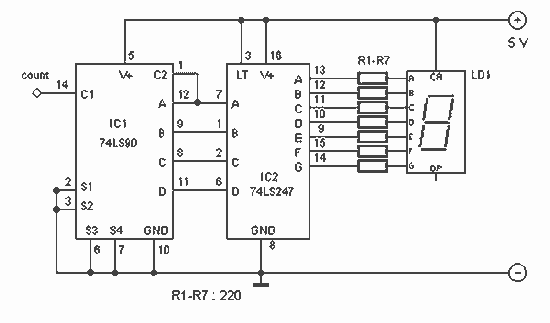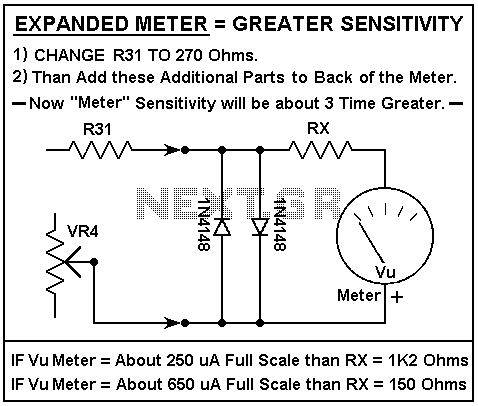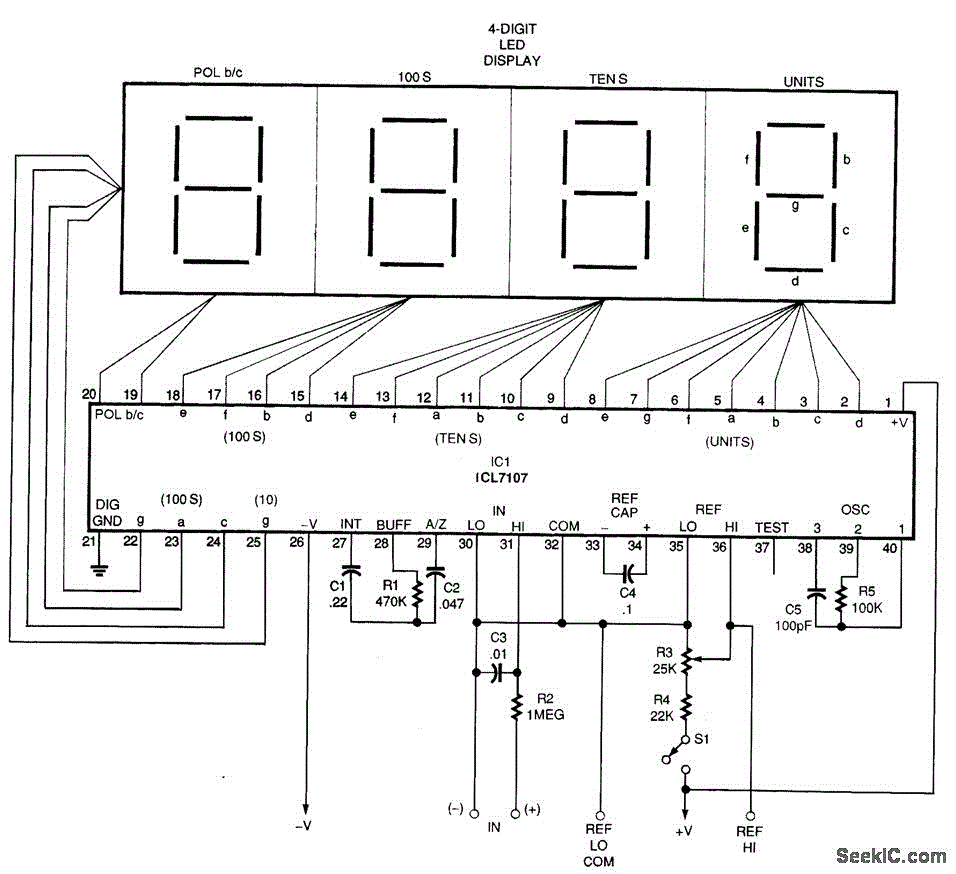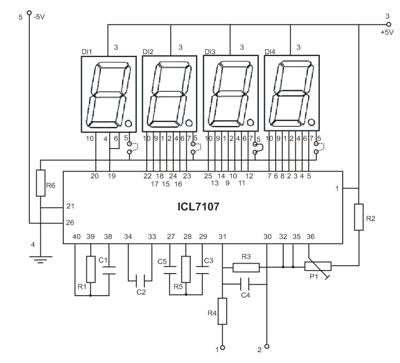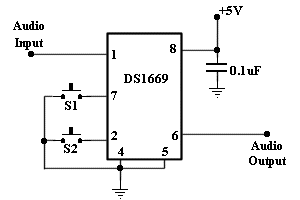
Digital pulse counter
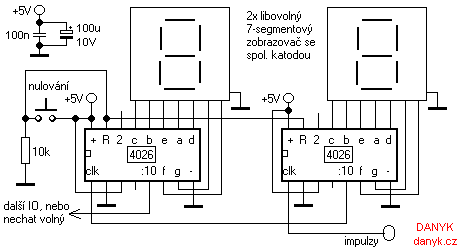
This is a simple digital pulse counter featuring 7-segment LED displays. The design allows for any number of digits, utilizing decimal counters such as the 4026 (including variants like MH4026, HCF4026, CD4026, etc.). An advantage of this configuration is the elimination of the need for binary decoders to convert BCD signals to 7-segment outputs. The displays used are common cathode types, like the DC56-11GWA. Resistors are unnecessary as the output from the I/O provides only a small current. The number of digits can be adjusted as required. The output "10" from the lower digit IC is always connected to the clock input of the higher digit IC. Pulses are fed into the clock input of the lowest digit IC. All ICs can be reset by pressing a button that applies a positive level to the RESET input. The circuit operates on a supply voltage of approximately 4 to 7V, which can be stabilized using a voltage regulator such as the 7805. The design is straightforward, making it suitable for beginners. This counter has various applications, including counting rotations on a winder, tallying products, monitoring failures, and assessing error conditions. It can also serve as a foundation for GM counters using a Geiger-Muller tube.
The digital pulse counter circuit is designed around the CD4026 series of integrated circuits, which function as decade counters. Each IC can drive a 7-segment display directly, allowing for a compact and efficient design. The common cathode configuration of the displays simplifies the connection, as the segments are activated by applying a high signal to their respective pins.
The circuit begins with the lowest digit IC, which receives clock pulses from an external source, such as a push-button switch or an oscillator, generating a pulse for each count. The output of this IC is connected to the clock input of the next higher digit IC, establishing a cascading effect. This means that when the lowest digit reaches 10, it will reset to 0 and increment the next digit, thus allowing for counting beyond single digits.
The reset functionality is crucial for initializing the counter. When the reset button is pressed, a high signal is sent to the RESET input of all connected ICs, ensuring that they all start counting from zero. This feature is particularly useful in applications where precise re-initialization is required.
Power supply considerations are important for the reliable operation of the circuit. The recommended voltage range of 4 to 7V is optimal for the CD4026 series, and the use of a voltage regulator like the 7805 ensures that the circuit receives a stable 5V supply, which is essential for consistent performance.
In terms of applications, this digital counter can be utilized in various fields. It can be employed in industrial settings for counting production cycles, in laboratories for monitoring experimental data, or in hobbyist projects for tracking events. The versatility of the design allows it to be adapted for specific needs, such as integrating with other sensors or systems for more complex counting tasks. Furthermore, the potential to use this counter as a base for a Geiger-Muller counter highlights its capabilities in radiation detection, which can be valuable in scientific research and safety monitoring.This is a simple digital counter of pulses with 7-segment LED displays. There may be any number of digits. I have chosen decimal counters 4026 (MH4026, HCF4026, CD4026, etc. ). Their advantage is that you don`t need binary decoders from BCD to 7-segment signal. Displays are common cathode, such DC56-11GWA. Resistors are not needed because the outpu t of IO gives only a small current. Number of digits is arbitrary. Output: "10" from a lower digit IC is always connected to the input (clk) of higher digit IC. Impulses are fed to the input clk of IC of lowest digit. All ICs are reset by pressing button, which brings a positive level on the RESET input. Circuit voltage supplied should be about 4 to 7V. It can be stabilizated using for example 7805. The design is very simple, and therefore it would not make problems to beginners. Counter has a broad application, such as counting turns on winder, counting products, failures, error conditions and so on. It can also be used as a basis of GM counters with Geiger-Muller tube. 🔗 External reference
The digital pulse counter circuit is designed around the CD4026 series of integrated circuits, which function as decade counters. Each IC can drive a 7-segment display directly, allowing for a compact and efficient design. The common cathode configuration of the displays simplifies the connection, as the segments are activated by applying a high signal to their respective pins.
The circuit begins with the lowest digit IC, which receives clock pulses from an external source, such as a push-button switch or an oscillator, generating a pulse for each count. The output of this IC is connected to the clock input of the next higher digit IC, establishing a cascading effect. This means that when the lowest digit reaches 10, it will reset to 0 and increment the next digit, thus allowing for counting beyond single digits.
The reset functionality is crucial for initializing the counter. When the reset button is pressed, a high signal is sent to the RESET input of all connected ICs, ensuring that they all start counting from zero. This feature is particularly useful in applications where precise re-initialization is required.
Power supply considerations are important for the reliable operation of the circuit. The recommended voltage range of 4 to 7V is optimal for the CD4026 series, and the use of a voltage regulator like the 7805 ensures that the circuit receives a stable 5V supply, which is essential for consistent performance.
In terms of applications, this digital counter can be utilized in various fields. It can be employed in industrial settings for counting production cycles, in laboratories for monitoring experimental data, or in hobbyist projects for tracking events. The versatility of the design allows it to be adapted for specific needs, such as integrating with other sensors or systems for more complex counting tasks. Furthermore, the potential to use this counter as a base for a Geiger-Muller counter highlights its capabilities in radiation detection, which can be valuable in scientific research and safety monitoring.This is a simple digital counter of pulses with 7-segment LED displays. There may be any number of digits. I have chosen decimal counters 4026 (MH4026, HCF4026, CD4026, etc. ). Their advantage is that you don`t need binary decoders from BCD to 7-segment signal. Displays are common cathode, such DC56-11GWA. Resistors are not needed because the outpu t of IO gives only a small current. Number of digits is arbitrary. Output: "10" from a lower digit IC is always connected to the input (clk) of higher digit IC. Impulses are fed to the input clk of IC of lowest digit. All ICs are reset by pressing button, which brings a positive level on the RESET input. Circuit voltage supplied should be about 4 to 7V. It can be stabilizated using for example 7805. The design is very simple, and therefore it would not make problems to beginners. Counter has a broad application, such as counting turns on winder, counting products, failures, error conditions and so on. It can also be used as a basis of GM counters with Geiger-Muller tube. 🔗 External reference
